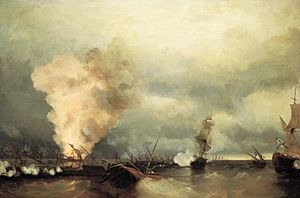
Back Spießrutenlauf von Wyborg German Viipurinlahden taistelu (1790) Finnish Bataille de la baie de Vyborg (1790) French Battaglia della baia di Vyborg (1790) Italian Выборгское морское сражение Russian Viborgska gatloppet Swedish
| Battle of Vyborg Bay | |||||||
|---|---|---|---|---|---|---|---|
| Part of the Russo-Swedish War (1788–90) | |||||||
 Battle of Vyborg Bay, by Ivan Aivazovsky | |||||||
| |||||||
| Belligerents | |||||||
|
|
| ||||||
| Commanders and leaders | |||||||
|
|
| ||||||
| Strength | |||||||
21,000 men[2] (number of cannon and men does not include rowing craft) |
22 ships of the line[1] 10 frigates[1] [NB 1]
3,000 naval cannons[2] | ||||||
| Casualties and losses | |||||||
The Battle of Vyborg Bay (or the Battle of Vyborg)[e] was a naval battle fought between Russia and Sweden on 3 July 1790 in Vyborg Bay off the coast of Vyborg during the Russo-Swedish War (1788–1790). The Swedish Navy suffered heavy losses, losing seven ships of the line and three frigates, but Gustav III of Sweden eventually ensured a Swedish naval escape through a Russian naval blockade composed of units of the Baltic Fleet, commanded by Admiral Vasily Chichagov.[8] British historians would later call the Battle of Vyborg Bay the "Baltic Trafalgar".[2] The battle ranks among the world's largest historical naval battles[not verified in body] and also among the most influential, as it introduced the naval battle concept of "firepower over mobility".[not verified in body]
- ^ a b c d e f g h i j k l m Выборгское морское сражение // Sytin Military Encyclopedia. Vol. 7: "Воинская честь — Гимнастика военная", pp. 99—101
- ^ a b c d e f g "Vyborg and Rochensalm (The History of Russian Navy)". Archived from the original on 14 April 2012. Retrieved 27 October 2011.
- ^ Novikov 1948, p. 140.
- ^ a b Sozaev E., Tredrea J. Russian Warships in the Age of Sail 1696-1860: Design, Construction, Careers and Fates. Seaforth Publishing. 2010. P. 67
- ^ Леер Г. А. (ред.) Энциклопедия военных и морских наук. СПб. Т. II. 1885. С. 341
- ^ Шопотов К. А. Выборгское морское сражение (к 210-летию) // Страницы Выборгской истории. Т. I. 2000. С. 158
- ^ a b Mattila (1983) p.208
- ^ Novikov 1948, p. 141.
Cite error: There are <ref group=lower-alpha> tags or {{efn}} templates on this page, but the references will not show without a {{reflist|group=lower-alpha}} template or {{notelist}} template (see the help page).
Cite error: There are <ref group=NB> tags on this page, but the references will not show without a {{reflist|group=NB}} template (see the help page).
© MMXXIII Rich X Search. We shall prevail. All rights reserved. Rich X Search